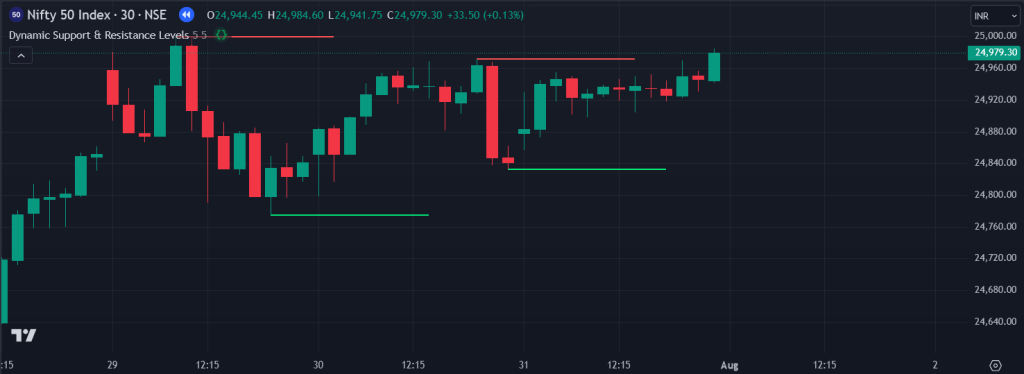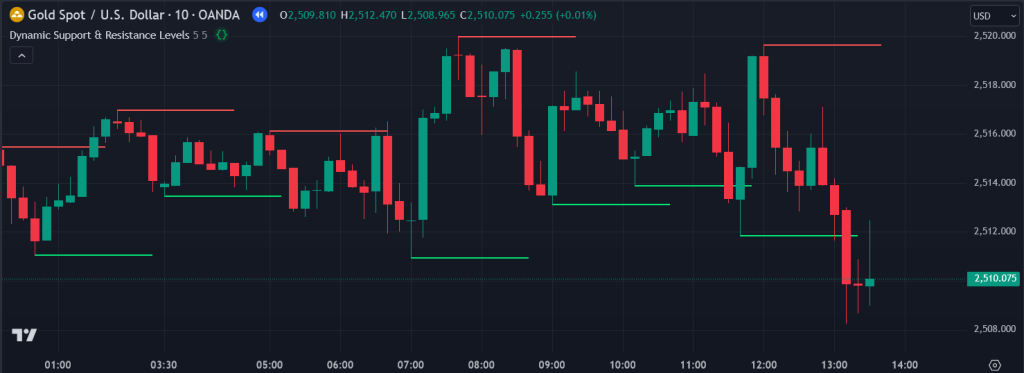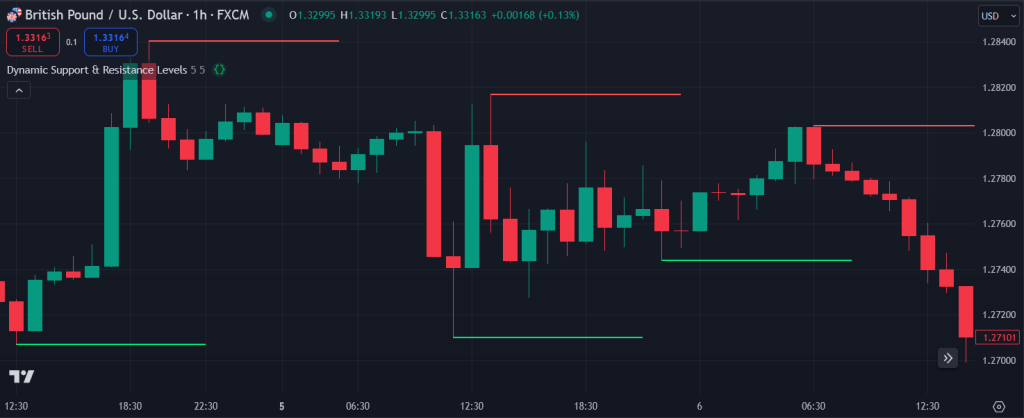🔓 Get All Tools for FREE!
- ✅ Click here to open a trading account using our referral link and start trading.
- 📅 After 7 days of active trading under our referral link, you can get access to all tools in your account.
- ⚠️ Keep trading to keep access free — if you're inactive for 7 days, your access will be removed.
- 👉 Already have an account? You can change the IB (introducing broker) to our referral link ( https://one.exnesstrack.org/a/w7syl3vnjb ) and still qualify!
In the fast-paced world of trading, the ability to spot pivotal price levels can be the difference between a successful trade and a missed opportunity. One such tool that offers an edge is the “Dynamic Support & Resistance Levels” indicator. This versatile indicator, available on platforms like TradingView, helps traders pinpoint significant price zones where markets may reverse or stall, leading to improved decision-making for both entry and exit strategies.
In this guide, we will delve into what makes this indicator essential, how it operates on TradingView, and why it enhances trading strategies by dynamically adjusting to market conditions.
What is the Dynamic Support & Resistance Levels Indicator?
Support and resistance are foundational concepts in technical analysis. Support levels represent price points where an asset tends to find buying interest, preventing it from falling further. Conversely, resistance levels are price zones where selling pressure prevents the price from rising. These areas are crucial for traders, as they often indicate points of reversal or consolidation.
🔓 Get All Tools for FREE!
- ✅ Click here to open a trading account using our referral link and start trading.
- 📅 After 7 days of active trading under our referral link, you can get access to all tools in your account.
- ⚠️ Keep trading to keep access free — if you're inactive for 7 days, your access will be removed.
- 👉 Already have an account? You can change the IB (introducing broker) to our referral link ( https://one.exnesstrack.org/a/w7syl3vnjb ) and still qualify!
The Dynamic Support & Resistance Levels indicator builds on this concept by automatically identifying key support and resistance zones based on recent price action. Unlike static horizontal lines drawn manually, this indicator uses real-time data to adjust and update levels, providing a more accurate reflection of current market conditions.
Key Features of the Dynamic Support & Resistance Levels Indicator
The Dynamic Support & Resistance Levels indicator provides the following essential features:
- Customizable Pivot Calculation: Traders can input the number of bars (candlesticks) to analyze when identifying pivot points. This customization allows traders to adjust the sensitivity of the indicator, depending on their strategy and time frame.
- Automatic Identification of Pivots: The indicator automatically detects pivot highs and lows based on recent price movements. Pivot highs represent potential resistance levels, while pivot lows signify potential support areas.
- Dynamic Plotting of Levels: The indicator plots these pivot highs and lows as resistance (red) and support (lime) lines, which extend forward on the chart. These lines dynamically update as new price bars form, offering traders an ongoing reference to the most critical market levels.
- Real-Time Updates: One of the primary benefits of this indicator is its ability to update in real time. As the market evolves and new highs or lows are made, the support and resistance lines shift accordingly, ensuring traders always have a fresh view of the current price landscape.

How the Indicator Works on a TradingView Chart
To fully understand the utility of this indicator, it’s essential to break down its operation on a TradingView chart.
1. User Inputs and Customization
When setting up the indicator, traders can customize the number of left and right bars used for pivot calculations. The left bars refer to the number of bars before the current price point, and the right bars refer to those that follow it. This feature allows traders to fine-tune the sensitivity of the indicator based on their preferred time frame and market volatility.
For example, on a short-term chart, a trader might use a smaller number of bars to quickly detect short-term support and resistance zones. In contrast, on a longer-term chart, more bars might be used to filter out minor fluctuations and focus on more significant market levels.
2. Pivot Identification
Once the user defines the bar range, the indicator starts scanning recent price action for pivot highs and pivot lows. A pivot high is identified when the high of a given bar is higher than the highs of the bars on either side of it. Similarly, a pivot low is detected when the low of a given bar is lower than the lows of the surrounding bars.
These pivots serve as the foundation for plotting dynamic support and resistance levels. Pivot highs signal potential resistance areas where the price might struggle to break through, while pivot lows indicate possible support zones where buyers could step in.
3. Dynamic Support and Resistance Lines
Once the pivots are identified, the indicator plots dynamic lines on the chart, marking key support and resistance areas. Resistance levels are typically drawn in red, signaling potential zones where the price may face selling pressure. Support levels are drawn in lime, highlighting areas where buyers might enter the market to prevent further price decline.
These lines extend forward from the pivot points, acting as future reference zones for traders. As the market moves and new pivots are formed, the dynamic lines adjust accordingly, always providing an up-to-date picture of critical market levels.
4. Real-Time Updates for Market Relevance
The Dynamic Support & Resistance Levels indicator is designed to reflect the ever-changing market environment. As new price bars form, the indicator continually reassesses support and resistance levels, updating the dynamic lines to reflect the latest price action. This real-time adjustment is crucial in fast-moving markets, where conditions can change in minutes.
For instance, if the price breaks above a resistance level, the previous resistance might turn into new support. The indicator will account for this shift, helping traders stay aligned with the current market trend.
Why Use the Dynamic Support & Resistance Levels Indicator?
There are several advantages to incorporating the Dynamic Support & Resistance Levels indicator into your trading strategy:
1. Enhanced Decision-Making
By identifying critical price levels where reversals or consolidations are likely to occur, this indicator allows traders to make more informed decisions. For example, if the price approaches a well-defined resistance level, traders might anticipate a potential reversal and plan their exit accordingly.
2. Improved Timing for Entries and Exits
The indicator provides clear visual cues for key support and resistance zones, allowing traders to time their entries and exits more precisely. Buying near support levels and selling near resistance levels can increase the chances of executing a successful trade.
3. Adaptability Across Timeframes
The ability to customize the number of bars used for pivot calculations means that this indicator can be applied across various timeframes, from minute charts to daily or weekly charts. This adaptability makes it suitable for both short-term and long-term traders.
4. Real-Time Updates for Accuracy
Markets are dynamic, and price levels that were relevant an hour ago may no longer hold. The indicator’s real-time updates ensure that traders always have access to the most current support and resistance levels, allowing them to react swiftly to changing conditions.

Pinescript Code of Dynamic Support & Resistance Levels
//@version=5
// insta id algo_aakash
indicator('Dynamic Support & Resistance Levels', overlay=true)
lb = input(defval=5, title='Left Bars')
rb = input(defval=5, title='Right Bars')
mb = lb + rb + 1
// Pivot High Logic
highestbars_1 = ta.highestbars(mb)
iff_1 = highestbars_1 == -lb ? high[lb] : na
// Pivot Low Logic
lowestbars_1 = ta.lowestbars(mb)
iff_2 = lowestbars_1 == -lb ? low[lb] : na
// Declare support and resistance lines
var line supLn = na
var line resLn = na
// Plot Resistance Line (Pivot High)
if not na(iff_1)
resLn := line.new(bar_index - rb, high[lb], bar_index + 5, high[lb], color=color.red, width=1)
// Plot Support Line (Pivot Low)
if not na(iff_2)
supLn := line.new(bar_index - rb, low[lb], bar_index + 5, low[lb], color=color.lime, width=1)

Conclusion
The Dynamic Support & Resistance Levels indicator is a powerful tool for traders seeking to identify critical price levels where market reversals or consolidations may occur. By automating the process of pinpointing these zones and continuously updating them in real time, this indicator enhances decision-making and timing for trades.
Disclaimer:
The information provided in this post is for educational and informational purposes only and should not be considered financial advice. Trading financial instruments such as stocks, forex, cryptocurrencies, and other assets carries inherent risk, and past performance is not indicative of future results. The use of indicators like the “Dynamic Support & Resistance Levels” does not guarantee success or profitability in trading. Always conduct your own research and seek the guidance of a licensed financial advisor before making any investment or trading decisions. The author and platform are not responsible for any losses incurred from the use of this information.

0 Comments